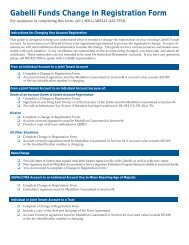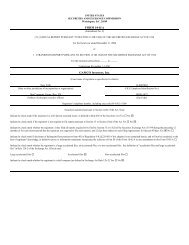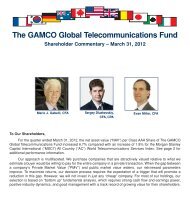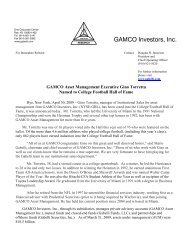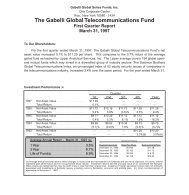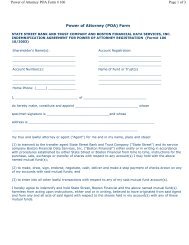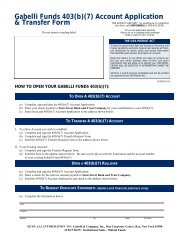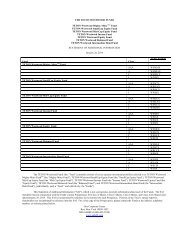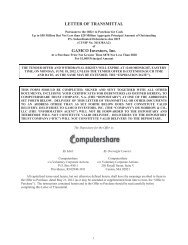Recent Annual Report - Gabelli
Recent Annual Report - Gabelli
Recent Annual Report - Gabelli
You also want an ePaper? Increase the reach of your titles
YUMPU automatically turns print PDFs into web optimized ePapers that Google loves.
The <strong>Gabelli</strong> Value Fund Inc.<br />
<strong>Annual</strong> <strong>Report</strong> — December 31, 2012<br />
To Our Shareholders,<br />
Christopher J. Marangi<br />
Portfolio Manager<br />
For the year ended December 31, 2012, the net asset value (“NAV”) per Class A Share of The <strong>Gabelli</strong><br />
Value Fund Inc. increased 17.0% compared with increases of 16.0% and 10.1% for the Standard & Poor’s<br />
(“S&P”) 500 Index and the Dow Jones Industrial Average, respectively. See page 3 for additional performance<br />
information.<br />
Enclosed are the schedule of investments and financial statements as of December 31, 2012.<br />
Performance Discussion (Unaudited)<br />
The stock market started the year with the best first quarter in over a decade. While gains were broad<br />
based, financials and housing related companies led the way. While the U.S. economy added 284,000 jobs in<br />
January 2012 and 227,000 in February, the unemployment rate continued to be high by historical standards.<br />
Data emanating from the second quarter – oil down 18%, copper lower by 9%, a slackening in job creation,<br />
and deceleration of production and retail sales – pointed to certain regions in recession. Central bankers hinted<br />
of further easing in order to soothe market nerves and prevent a negative feedback loop from emerging.<br />
U.S. stock prices marched upward each month during the third quarter, with the S&P finishing up 6.35%<br />
for the quarter and 16.00% year to date. While economic growth remained sluggish, the market decided to<br />
focus instead on monetary policy, both in the U.S. and abroad. In late July, European Central Bank President<br />
Mario Draghi vowed to do “whatever it takes to preserve the euro” and followed up in September by announcing<br />
Outright Monetary Transactions that would “provide a fully effective backstop to avoid destructive scenarios.”<br />
Ben Bernanke paved the way in August with the announcement of an additional round of quantitative easing,<br />
which is being called “QE3” or even “QE infinity.”<br />
The developed world continued major deleveraging as overconsumption financed by debt constrained<br />
growth and pressured federal, state, and local government budgets. The developing world faced its own issues<br />
as nations, primarily in Asia and Latin America, attempted to command economic forces largely beyond their<br />
control. China underwent its own political transition, and was hard pressed to engineer a “soft landing” for its<br />
economy.




